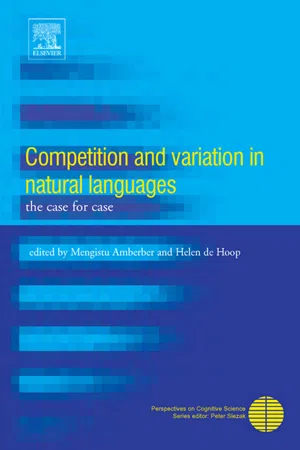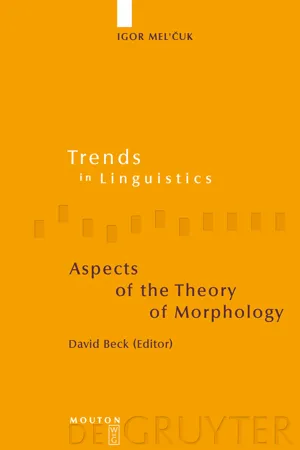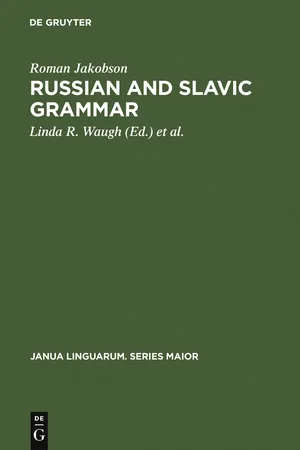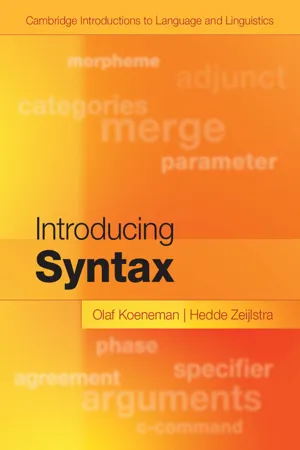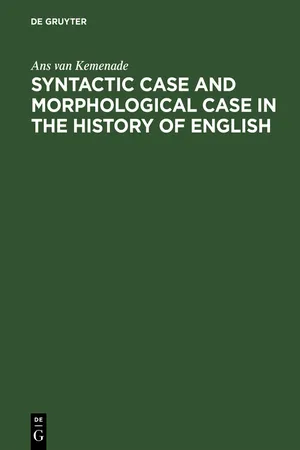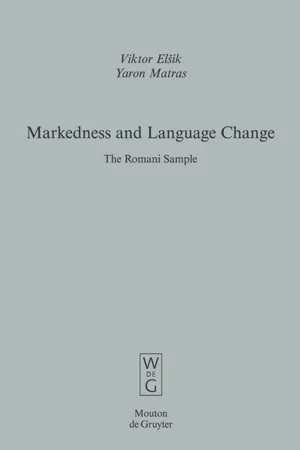Languages & Linguistics
Case
In linguistics, a "case" refers to the grammatical category that indicates the relationship between a noun or pronoun and other words in a sentence. It typically reflects the noun's role as a subject, object, or possessor. Different languages have varying case systems, with some using inflections on nouns and pronouns to denote case, while others rely on word order or prepositions.
Written by Perlego with AI-assistance
Related key terms
1 of 5
10 Key excerpts on "Case"
- eBook - PDF
Competition and Variation in Natural Languages
The Case for Case
- Mengistu Amberber, Helen de Hoop(Authors)
- 2005(Publication Date)
- Elsevier Science(Publisher)
Chapter 6 Case as Feature Checking and the Status of Predicate Initial Languages Lisa deMena Travis 1. Introduction The notion of Case is central to grammar. This is immediately clear to a learner of a second language which has Case morphemes. Some grammatical notions such as categories (e.g. N and V) have, at least in the core examples, a link to extra-lin-guistic notions (e.g. thing and action). Case, however, appears much more closely tied to purely linguistic phenomena. Case alternations offer a glimpse into the inner mechanisms of language such as category distinctions (nouns vs. verbs), grammatical functions (subjects vs. objects vs. indirect objects), the status of argu-ments and adjuncts (e.g. Dative vs. Accusative DPs within German PPs), and aspectual distinctions (e.g. Accusative vs. Partitive Case in Finnish). Nominative Case is particularly interesting in this respect because it is closely connected to the syntactic notion of subject and independent of the more semantic notion of theta-role (e.g. Agent). Below we see Nominative Case on an Agent (1a), an Experiencer (1b), an Instrument (1c), a Theme (1d, 1e) and a Goal (1f). (1) a. The children broke the gift b. The children loved the gift c. The key opened the door d. The gift broke e. The gift was given to the children f. The children were given a gift Competition and Variation in Natural Languages: The Case for Case Edited by M. Amberber and H. de Hoop Copyright © 2005 by Elsevier Ltd. All rights of reproduction in any form reserved ISBN: 0-08-044651-5 147 In this chapter, I look at the role of Case, and in particular Nominative Case, in a specific theoretical context and then in a certain language family. The theo-retical context is that of the Minimalist Program of Chomsky (1995, 2000, 2001) and its theoretical predecessors such as the Government Binding (GB) framework of Chomsky (1981). - eBook - PDF
Process linguistics
Exploring the processual aspects of language and language use, and the methods of their description
- Thomas T. Ballmer, Wolfgang Wildgen, Thomas T. Ballmer, Wolfgang Wildgen(Authors)
- 2017(Publication Date)
- De Gruyter Mouton(Publisher)
( 1 1 ) Fig. 2 55 2. Case Theory 2.1 About the Inadequacy of some Case Definitions Traditional Case definitions are of two kinds. They are either morpho-syntactical, and exclude any reference to semantical notions and hence lack of any content, or, they are semantical, in the sense that they refer to so called Case rôles (or simply: rôles), and then lack any straightforward relation to the expressive means of the language in question. Thus Duden (1973), e.g., gives the following definition: (12) The Case and rôle of the noun in the sentence is thus characterized: as subject it stands in the nominative, as object in the accusative, dative, genetive etc. As it turns out in the subsequent text, Cases are conceived exclusively, syntactically and on a purely formal level in accordance with what is governed by the verb. No semantic characterization of the notion of Case is given and, in particular, none that would differentiate between the various Cases. Specific Case definitions turn out to be nothing but circular. The notions of Case and rôle are used indiscriminately without any obvious reason. Dirven/Radden (1977) propose the following definition: (13) A Case or semantic rôle is a complement determined by certain features standing in a constant relation to the predicator. It does not seem to be clear what 'constant relation' means: constant with respect to which variation? The positive aspect of this definition is certainly its explicit relation to semantics. Being in the vein of Fillmore (1968), Dirven/Radden's approach, however, exhibits similar deficiencies. Thus it is fatal for both 56 approaches not to carefully distinguish between Cases and roles. We observe again an indiscriminate use of these notions. These are quasi-synonymously used and confused as is demonstrated by the following argument. - eBook - PDF
Reinventing Structuralism
What Sign Relations Reveal About Consciousness
- Rodney B. Sangster(Author)
- 2013(Publication Date)
- De Gruyter Mouton(Publisher)
5 Case relations as a product of grammatical selection In much of the research on Case relations, particularly in generative grammar, it is assumed that there is a set of functions that noun phrases fulfill with respect to verbs in an utterance. Thus a given noun phrase may be marked for such notions as agent, patient, cause, effect, instrument, object, or goal, depending on the role it appears to play vis-à-vis the action denoted by the verb. These functions are taken to be universals representing various kinds of states, events, and processes. (Lyons 1977: 488) In Chomsky’s Minimalist Pro-gram, it is explicitly assumed that “Case is always present abstractly,” whether or not it is morphologically manifested or indeed has any overt formal realiza-tion at all. In this formulation, “the subject of a finite clause is assigned nomi-native Case, the object of a transitive verb is assigned accusative Case,” and so forth. (Chomsky 1996: 110) It is also understood in this approach, moreover, that even in languages that do have an overt Case system, there is by no means always a direct correlation between such presumed universal categories and the actual Case forms used to express them; and in such instances a device is mechanically inserted into the underlying system, a so-called Case filter, to adjust it so that one arrives at the correct surface structure derivation. Such would frequently have to be the Case in Russian, to be sure, since the objects of transitive verbs regularly appear in either the accusative, the genitive, or the instrumental; and even the subject of an existential sentence under negation, as we noted previously, will occur in the genitive rather than the nominative. Such a procedure implies, of course, that the actual Case forms of inflectional languages are mere surface realizations of constructs that have no necessary relation to the signifiers used to express them. - eBook - PDF
- Igor Mel'cuk, David Beck(Authors)
- 2008(Publication Date)
- De Gruyter Mouton(Publisher)
Because of this, numerical indices will be used to keep the three senses of the noun Case strictly separated. 2 2. Three concepts of Case : Definitions 2.1 – 2.3 The prototypical examples of the category of Case I.1a are taken to be Case I.1a in Slavic languages (Russian, Serbian, Polish), in classical languages (Latin and Ancient Greek), in Sanskrit and in German, as well as in Georgian, Lezgian, Finnish and Hungarian. In all these languages, the presence and the nature of Case I.1a seem indisputable. Based on the analysis of such prototypical Cases I.1a , the general concept of Case I.1a will be proposed. Informally speaking, I define Case I.1a as an inflectional category of nomi-nals which has the two following properties: (i) In language L , Case I.1a : a) necessarily serves to mark the passive SSynt-role of a nominal N – that is, to mark the SSynt-dependency relation between N and another ele-ment of the clause (= the SSynt-Governor of N); b) potentially serves to express the semantic relation between N and its SSynt-Governor. (ii) In language L , Case I.1a is significantly involved in the grammar of L such that a) it contains at least two different Cases I.1b expressing two different ac-tantial SSynt-roles of nominals; 3 or b) it is relevant to agreement; or c) it cumulates with other grammemes; or 112 Chapter 2. Case d) it is relevant to morphonology. The formal definition of Case I.1a which follows is fairly complex; hopefully, its complexity reflects the actual state of affairs rather than my inability to come up with something simpler. After all, grammatical Case IS known to be an exceed-ingly complex concept. Definition 2.1: CaseI.1a Case I.1a is an inflectional category C of nominals (in language L ) such that Condi-tions 1 and 2 are simultaneously satisfied: 1. - eBook - PDF
Cases and Thematic Roles
Ergative, Accusative and Active
- Beatrice Primus(Author)
- 2010(Publication Date)
- De Gruyter(Publisher)
2 Cases 2.1 General Remarks In this work, Cases are taken to be basic, primitive notions. This means that they are not defined in terms of some other primitive notions, but simply posited to exist. However, even primitive notions receive empirical substance by the rules they occur in. The formal view of Cases defended in this book is expressed by the fact that the Cases discussed here and their hierarchy are given formal sub-stance by proposing various formal rules they are involved in. These universal preferences also contribute towards the identification of Cases and their hier-archy in a particular language. The independence of Cases from other relational concepts of grammar is one of the main assumptions of this work. The order in which the Cases are aligned in various descriptive grammars originated in Ancient Greek and Latin grammars: nominative, genitive, dative and accusative. Apart from the position of the nominative, this ordering proves to be linguistically arbitrary. Jakobson's work (1936) can be cited as one of the first attempts towards a linguistically motivated hierarchization of Cases and his observations imply the hierarchy proposed here: nominative < accusative < da-tive. Jakobson's results are based on the functional markedness of the Cases, with the nominative as the semantically least determined and the dative as the seman-tically most restricted Case. Within our approach, this functional asymmetry, in so far at it is correct, can be derived from subcategorization restrictions. The verb-governed nominative has the fewest subcategorization restrictions, and consequently it is also the Case with the greatest range of semantic functions. The verb-governed accusative comes second and the verb-governed dative third with respect to subcategorization restrictions (cf. section 2.3 in this chapter). This book focuses on the Cases of verb arguments and this means that Cases are used as relational concepts. - eBook - PDF
Russian and Slavic Grammar
Studies 1931-1981
- Roman Jakobson, Linda R. Waugh, Morris Malle, Linda R. Waugh, Morris Malle(Authors)
- 2011(Publication Date)
- De Gruyter Mouton(Publisher)
The importance of the new book lies in its critical overview of older Case theories and in its clear and carefully thought out formulation of the problem. His major theses relate to the first-rate work of Wüllner, which anticipated them by centuries: A grammar is a theory of basic meanings or values and of the system formed by means of them, and it must proceed empirically in accomplishing its task (Hjelmslev, 84). With this formulation, Hjelmslev uncovers three central problems: basic meaning, system, and empirical procedure. The first concept is clarified by the following definition: A Case, like lin-guistic units in general, does not mean several different things; it means one single thing — it carries a single abstract concept, from which concrete appli-cations can be derived (85). I take issue only with the term basic meaning (signification fundamentale), which can easily be confused with the designa-tion principal meaning (signification principale), while what the author has in mind is more accurately expressed by the term general meaning (signifi-cation generate). There can be no objection to the demand for an empirical (that is, im-manent and language-internal) procedure; indeed, a more consistent applica-tion of such a procedure is called for. It is improper not only to keep apart that which from the linguistic point of view belongs together, but also to combine, artificially, that which from the linguistic point of view is separate. Not only two grammatical forms, but even two form classes, indicate a dif-ference in value. The word in language is a functional unit, which differs fundamentally from a phrase. The form of the word and the form of the phrase represent distinct planes of linguistic value. One can therefore speak GENERAL MEANINGS OF THE RUSSIAN CaseS 63 not only of the difference between the general meanings of two Case cate-gories, but also of the difference between the general meanings of the categories Vord'and 'phrase'. - eBook - PDF
Syntactic Change
Toward a Theory of Historical Syntax
- Jan T. Faarlund(Author)
- 2011(Publication Date)
- De Gruyter Mouton(Publisher)
Chapter five Some consequences The mechanisms involved in syntactic change that I have discussed in the previous two chapters, have had their effects in various, partly independent parts of the syntax of Nordic. In this final chapter, some of those areas of syntax will be discussed separately. 5.1. Case systems By Case system I understand a system by which NPs are marked morphologi-cally to indicate their grammatical functions. For a given language it is possible to identify a finite number of Cases. An NP is marked for a certain Case through a process of Case assignment. Cases convey information of different kinds, depending on the language as well as on the individual Case. Consider for example the German dative Case, as in (1) Sie gab mir das Buch she gave me-D the book The dative here may be said to indicate the recipient, that is the Locus role, but not every Locus associates with the dative: (2) Ich bekam das Buch I-N received the book On the other hand, the dative clearly also represents other semantic roles, as in (3) Sie tötete ihn mit einem Messer she killed him with a knife-D 138 Some consequences Rather than defining Cases semantically, a more successful solution in some languages might be to describe them as assigned to certain syntactic categories or to certain structural positions. The dative might be assigned to the first object of ditransitive verbs, as in (1), and to the object of a preposition, as in (3). This is what I will call structural Case assignment. Yet, structural Case assignment has only partly replaced semantic Case assignment in some Germanic languages. In German, for example, the dative competes with other Cases in several positions, with the accusative as direct object (4), and as the object of a preposition (compare 3 and 5), and in some languages even with the nominative as a subject - consider the Faroese sentence (6) (from Barnes 1986: 19), where the dative phrase triggers a reflexive form of the possessive in the object NP. - eBook - PDF
- Olaf Koeneman, Hedde Zeijlstra(Authors)
- 2017(Publication Date)
- Cambridge University Press(Publisher)
82 INTRODUCING SYNTAX a subject or object), we will conclude that Case theory puts restrictions on nominal arguments in general, irrespective of whether they are pro- nouns or not. Case plays a role even if you do not see it. But before you can appreciate this insight, we first have to go through the basics. Exercises A1 Use the pronouns in the following sentence pairs to argue that there is no one-to-one correspondence between specific θ-roles and specific Case assignments. a. (i) Fred praised her a lot. (ii) Fred gave her a compliment. b. (i) Give him the double espresso. (ii) Give the double espresso to him. c. (i) Ahmed expected her. (ii) Ahmed expected her to leave. d. (i) I left. (ii) Daisy wanted me to leave. e. (i) The manager of the local zoo fired her. (ii) She was fired by the manager of the local zoo. B2 Use the pronouns in the following sentence pairs to argue that there is no one-to-one correspondence between specific grammatical functions (subject of a main clause, subject of an embedded clause, direct object, indirect object) and specific Cases. a. (i) I left. (ii) Daisy wanted me to leave. b. (i) They expected to earn a lot of money. (ii) Annie expected them to earn a lot of money. c. (i) Ahmed expected her. (ii) Ahmed expected her to leave. d. (i) Show him the exit. (ii) Show him to Sharon. 4.2 Implementation: Case-Assigning Heads We observed in the previous section that pronouns need to appear in a particular Case form and that a sentence becomes ungrammatical if a wrong Case form is chosen. For this reason, he cannot appear where him can appear, and vice versa. The same is true for she and her, me and I, etc. What we need, then, is a theory that determines which Case forms can appear in which positions, and this theory needs to be as explicit as pos- sible about the mechanisms that ensure the proper distinction between grammatical and ungrammatical sentences. - Ans van Kemenade(Author)
- 2016(Publication Date)
- De Gruyter Mouton(Publisher)
CHAPTER 3 Syntactic Case and morphological Case The aim of this chapter is to establish some core properties of syntactic Case and morphological Case in OE, and the relationship between them. Case theory as it is embedded in GB theory enables us to cast light on the relation-ship between a number of superficially unrelated syntactic phenomena in OE, notably various types of passive constructions, constructions with transitive adjectives, and word order. This provides a further context for a number of observations and analyses presented in chapter 2. Also it provides the necessary basis for the analyses of clitics and preposition stranding in chapters 4 and 5 and for an understanding of the diachronic development subsequent to OE and its theoretical implications, as discussed in chapter 6. Our treatment of syntactic Case follows proposals for Case theory such as those in Rouveret & Vergnaud (1980); Chomsky (1981); Kayne (1981); Lightfoot (1981). Case theory within GB theory has so far been almost exclusively con-cerned with syntactic Case forms. Syntactic Case forms are abstract properties that categories occupying argument positions receive from a Case-marking head, and that play a role at abstract levels in the grammar. Section 3.1 will discuss syntactic Case in more detail, making a crucial distinction between structural syntactic Case and oblique syntactic Case, and defining the properties of both types of Case relevant to the various components of the grammar, and to the analysis of particular constructions. Given such a theory of abstract Case, it is of interest to see how such abstract Case forms are related to morphological Case forms as we know them in inflected languages such as OE. We will proceed on the assumption that there is such a relationship.- eBook - PDF
Markedness and Language Change
The Romani Sample
- Viktor Elšik, Yaron Matras(Authors)
- 2008(Publication Date)
- De Gruyter Mouton(Publisher)
The category of external Case has six values: the accusative, the dative, the locative, the ablative, the sociative (also called instrumental), and the genitive (also called possessive). The external Case suffixes (-ke ~ -ge, -te ~ -de etc., see Table 16.1) follow the (internal) oblique suffix. From a diachronic perspective, they have been termed Layer II Case markers. The overall number of inflectional Cases in nouns is eight (viz. three inter- nal Cases, with the oblique being differentiated into six external Cases), while there are only two distinct Cases in adjectivals. Internal Case markers cumulate number and gender, both in substantivals (with the exception of certain pro- nouns which do not encode number and or gender) and in adjectivals. External Case markers are separatist, although each overt external marker has two vari- ants, whose distribution is sensitive to number to a great extent (see Section 16.6 for details). The third Case-related category is the category of Case roles. We define Case roles as grammatical relations and/or thematic roles encoded by inflectional Case and adpositions, with the exception of local and temporal Case relations. 3 We divide Case roles into two sets of values: core Case roles and adverbial Case roles. Core Case roles include the values: Subject (canonical transitive or intransitive subject), Experiencer (experiencer or undergoer as non-canon- ical subject), Predicative (nominal predicate), Object (direct object), Recipi- ent, Possessee (clausal possessee), Possessor (clausal possessor), Adnominal Possessor, and External Possessor (possessor expressed as a core grammatical relation of the verb in a constituent separate from that which contains the pos- sessed item; cf. Payne and Barshi 1999).
Index pages curate the most relevant extracts from our library of academic textbooks. They’ve been created using an in-house natural language model (NLM), each adding context and meaning to key research topics.
